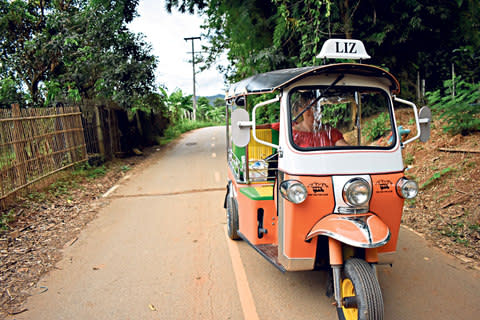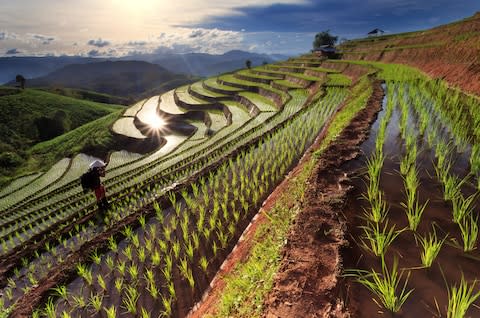Fancy driving a tuk-tuk in Thailand? Here's how you can

From my rear-view mirror, I see a group of young men gawping from the back of a jeep; a farmer straightens his back and stares; there are smiles and looks of wonder everywhere I go – even a passing monk gives me a wave. It’s been a while since I’ve attracted this many admiring looks. But it’s not me they’re checking out; it’s me driving a tuk-tuk.
It’s one of Thailand’s most instantly recognisable symbols; a half-motorbike, half-car mash-up, with three wheels, flashing lights and an acid-bright paint job, generally seen zigzagging tourists around the fume-filled streets of Bangkok, piloted by complete and utter lunatic cabbies.
But now I’m the one in the driving seat, whizzing through neon-green paddy fields in a tango-orange trike named Liz, one of the first travellers to try out the newly established Tuk Tuk Club’s one-day driving tour.
The Club’s fleet of six specially commissioned vehicles are based in the Mae Wang valley, about an hour outside Chiang Mai, and it’s from here that daytrippers set off on a convoy through the sleepy northern Thai countryside. Before hitting the road proper, there’s a full safety briefing, a driving lesson and a practice session turning and reversing between cones.
The cab feels surprisingly sturdy and the controls are fairly straightforward – the throttle on the right-side handlebar, the brake at the right-foot pedal, the clutch on the left, with a clunky gearbox positioned between the driver’s legs.

In first gear, the engines, though a paltry 160cc, roar as though they belong on a jumbo jet – terrific fun. And while the top speed is restricted to 50kph (31mph), when your vehicle has three wheels and no doors, the pace feels enjoyably fast. The only real challenge is not using the foot brake when I mean to accelerate, but much like switching from a manual car to an automatic, my brain quickly adapts and within half an hour I’m up and down the gears like a pro. Danger-wise, my only concern is the comically soft suspension, with the bounce of my 36Cs leaving me at risk of two black eyes.
Out on the road, the ride is pure unadulterated joy – noisy revving, sun on my face, wind in my hair, much waving and cheerful whooping from amused villagers who clearly can’t believe what they’re seeing. There’s little in the way of traffic and Liz is nippy enough to manoeuvre out of the way when a car or bike does come along. And the scenery is show-stopping, particularly when we slip off the main drag on to a single-track lane leading past stilted teak houses and mango, loganberry and roseapple farms to the jungle temple of Wat Tham Nam Ho. As Thai temples go, it’s a modest affair, barely more than a tin shed, with a shining blue-tiled floor, a snowy-white statue of Buddha, and a solitary monk.
We dismount and stretch our legs with a 15-minute climb up the hillside to the temple’s gold-topped stupa and a viewpoint providing an astonishing hit of green – a bliss-inducing scene.
En route to lunch, the next stretch of road rolls past tiny villages, bamboo groves and swaying rice fields dotted with water buffalo – turning every corner a thing of wonder – before winding uphill to a charming garden café serving wholesome bowls of wheat noodle khao soi, aromatic pork curry and zingy som tam salad.

It’s the perfect fuel for the last part of the journey, which takes us to the Mae Wang Elephant Home – a former elephant-riding camp recently turned rehabilitation centre. It’s a humble set-up with just six resident elephants, including two adorable babies, which we observe from a respectful distance as they feed from their mothers. Two hours are spent here; walking with the herd, feeding them corn, pineapple and bananas, and wading into the river to throw buckets of water over them while they bathe.
The travel bucket list: 25 things to do before you die
It’s a pleasingly mucky and thoroughly magical experience, and heart-warming to know that more and more elephant camps are converting to a more ethical model, free from bull hooks and back-breaking rides.
Happily exhausted, we end the tour floating serenely down the Mae Wang River on bamboo rafts, followed by one last blast on the tuk tuks back to base camp. I feel sad to hand over the keys. I may only have been at the wheel/handlebars for one day, but the excitement of learning to drive a new vehicle, the marvellous scenery and welcoming people have made it feel like an epic road trip.
How to do it
Wix Squared (020 3808 6383; wixsquared.com) offers 5 nights in Chiang Mai from £1,900pp, including a stay at 137 Pillars, breakfast, return flights, transfers and a day’s tuk tuk driving lesson with the Tuk Tuk Club.